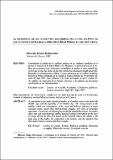Por favor, use este identificador para citar o enlazar a este item:
http://hdl.handle.net/10261/19959COMPARTIR / EXPORTAR:
 SHARE
BASE SHARE
BASE
|
|
| Visualizar otros formatos: MARC | Dublin Core | RDF | ORE | MODS | METS | DIDL | DATACITE | |

| Campo DC | Valor | Lengua/Idioma |
|---|---|---|
| dc.contributor.author | Diago Hernando, Máximo | - |
| dc.date.accessioned | 2010-01-12T11:28:39Z | - |
| dc.date.available | 2010-01-12T11:28:39Z | - |
| dc.date.issued | 2009-12-30 | - |
| dc.identifier.citation | Hispania 69(233): 683-714 (2009) | en_US |
| dc.identifier.issn | 0018-2141 | - |
| dc.identifier.uri | http://hdl.handle.net/10261/19959 | - |
| dc.description | 31 páginas. | en_US |
| dc.description.abstract | [ES] Contribución al estudio de los conflictos políticos en las ciudades castellanas en el período de tránsito de la Edad Media a la Moderna. La fuerte presencia de la nobleza que caracterizó a las estructuras sociopolíticas de muchas de estas ciudades favoreció que en ellas las luchas de facciones nobiliarias alcanzasen notable desarrollo. Basándose en documentación inédita, el autor demuestra que el conflicto banderizo persistió de forma continuada en la ciudad de Cuenca durante las tres primeras décadas del siglo XVI. Hace referencia a los hechos principales en que se tradujo dicho conflicto, la composición de los bandos o facciones, y los objetivos que perseguían sus dirigentes en sus enfrentamientos. | en_US |
| dc.description.abstract | [EN] A contribution to the study of political conflicts in Castilian towns at the end of the Middle Ages and the beginning of the Modern Age. The strong presence of the nobility, which was characteristic of the social and political structures of many Castilian towns, meant that inter-factional struggles were often of particular importance. On the basis of information provided by unpublished sources, the author shows that such inter-factional conflicts persisted without interruption in the town of Cuenca during the three first decades of the sixteenth century. He alludes to the main facts of the conflict, the composition of the factions, and the objectives that their leaders hoped to attain with their struggles. | en_US |
| dc.format.extent | 160945 bytes | - |
| dc.format.mimetype | application/pdf | - |
| dc.language.iso | spa | en_US |
| dc.publisher | Consejo Superior de Investigaciones Científicas (España) | en_US |
| dc.rights | openAccess | en_US |
| dc.subject | Corona de Castilla | en_US |
| dc.subject | Ciudades | en_US |
| dc.subject | Conflictos políticos | en_US |
| dc.subject | Luchas de bandos | en_US |
| dc.subject | Siglo XV | en_US |
| dc.subject | Siglo XVI | en_US |
| dc.subject | Crown of Castile | en_US |
| dc.subject | Towns | en_US |
| dc.subject | Political conflicts | en_US |
| dc.subject | Factional struggles | en_US |
| dc.subject | Fifteenth century | en_US |
| dc.subject | Sixteenth century | en_US |
| dc.title | La incidencia de los conflictos banderizos en la vida política de las ciudades castellanas a fines de la Edad Media: El caso de Cuenca | en_US |
| dc.title.alternative | The incidence of factional conflicts in the political life of Castilian towns at the end of the Middle Ages: The case of Cuenca | en_US |
| dc.type | artículo | en_US |
| dc.description.peerreviewed | Peer reviewed | en_US |
| dc.relation.publisherversion | http://hispania.revistas.csic.es/index.php/hispania/article/view/117 | en_US |
| dc.identifier.e-issn | 1988-8368 | - |
| dc.contributor.orcid | Diago Hernando, Máximo [0000-0003-2118-5086] | - |
| dc.type.coar | http://purl.org/coar/resource_type/c_6501 | es_ES |
| item.openairecristype | http://purl.org/coar/resource_type/c_18cf | - |
| item.fulltext | With Fulltext | - |
| item.cerifentitytype | Publications | - |
| item.openairetype | artículo | - |
| item.languageiso639-1 | es | - |
| item.grantfulltext | open | - |
| Aparece en las colecciones: | (CCHS-IH) Artículos | |
Ficheros en este ítem:
| Fichero | Descripción | Tamaño | Formato | |
|---|---|---|---|---|
| 119.pdf | 157,17 kB | Adobe PDF |  Visualizar/Abrir |
CORE Recommender
Page view(s)
380
checked on 19-abr-2024
Download(s)
329
checked on 19-abr-2024
Google ScholarTM
Check
NOTA: Los ítems de Digital.CSIC están protegidos por copyright, con todos los derechos reservados, a menos que se indique lo contrario.
